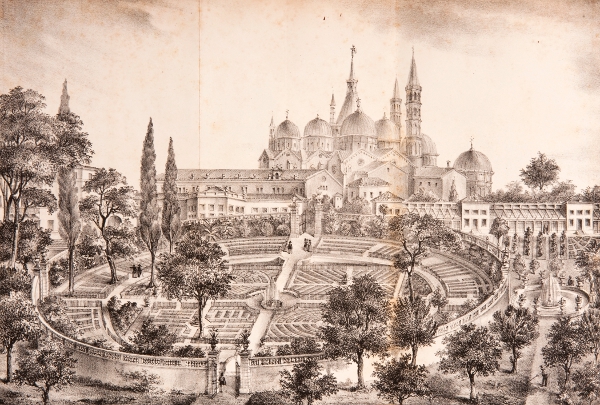
image courtesy of the LuEster T. Mertz Library of the New York Botanical Garden
Tuesday, 14 May 2013
The Italian Renaissance Garden at the New York Botanical Garden
Orto Botanico di Padua. A major component of the multifaceted, Garden-wide Wild Medicine exhibition is a display in the Enid Haupt Conservatory.
The 16th century roots of botanic gardens lay in medicine, their focus on the growth of medicinal plants. Orto dei semplici, the so-called "simple plants" which produced natural remedies, and especially important to teach students how to distinguish useful, legitimate medicinal plants from false ones. Noted for its historical design, the Orto Botanico di Padova in Padua, in northern east part of Italy, is the world's oldest academic botanical garden that is still in its original location. Founded in 1545 was created upon deliberation of the Senate of the Venetian Republic.

image courtesy of the LuEster T. Mertz Library of the New York Botanical Garden
An engraving of the Giardino Botanico di Padova in L'Orto botanico di Padova nell'anno MDCCCXLII, published in 1842.
It is one of The Renaissance Herbals on display in the the Rondina and LoFaro Gallery of the LuEsther T. Mertz Library.
Designed as a square within an enclosing circular wall, this shape in part because of the irregular plot of land on which the garden was built
and also to protect the garden from the frequent night thefts which occurred in spite of severe penalties - not only fines or prison, but even exile.
As part of the exhibition, here reimagined, the circular shape of the main garden at Padua, with four square beds separated by crossing paths.

.
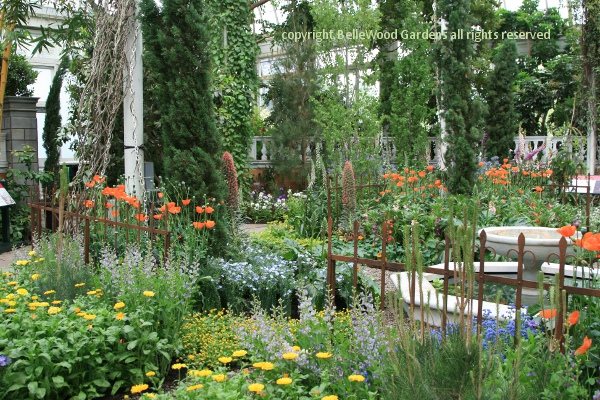
.

Here evoking the Padua garden's large limestone columns, curved benches, brick balustrades,
and other columns featuring the seven "rules" mark the entrance to The Italian Renaissance Garden.
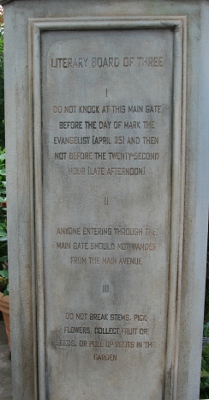 . .
. . 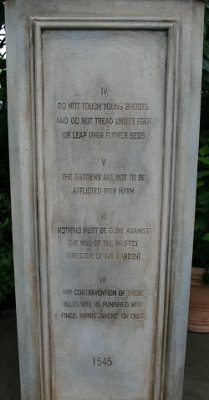
Some things never change. Do Not, visitors are ajured : III Don't break stems, pick flowers, collect fruit or seeds
IV Do not touch young shoots and do not tread underfoot or leap over the flower beds. Precepts still sound today.
A changing display of approximately 250 different medicinal plants will be on display over the four months of the exhibition - May 18 through September 8.
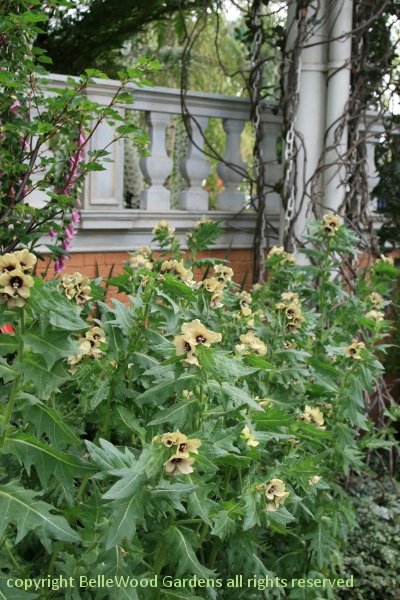
Black henbane, Hyoscyamus niger, one of the herbs used for the witches brew
that gives a hallucinatory illusion of flying. Though it does have medicinal uses
this member of the Solanaceae, the same family as tomatoes and eggplants is
extremely dangerous, causing delirium and convulsions unless used with great care.
Black henbane, fat hen. A careless error just a few years ago, one that could have had very unfortunate results, would certainly have earned celebrity chef Antony Worrall Thompson a failing grade at the Orto Botanico di Padua. He recommended henbane as a "tasty addition to salads" in the August 2008 issue of Healthy and Organic Living magazine, confusing the toxic herb with fat hen, Chenopodium albus, a member of the spinach family. Though he apologized, and the magazine sent subscribers an urgent message stating that henbane is a very toxic plant and should never be eaten, it is a case in point as to why careful research and study, and thorough knowledge of the plants and their uses is vitally important.
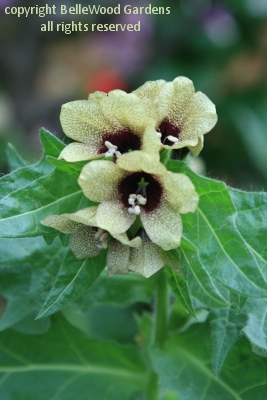
.
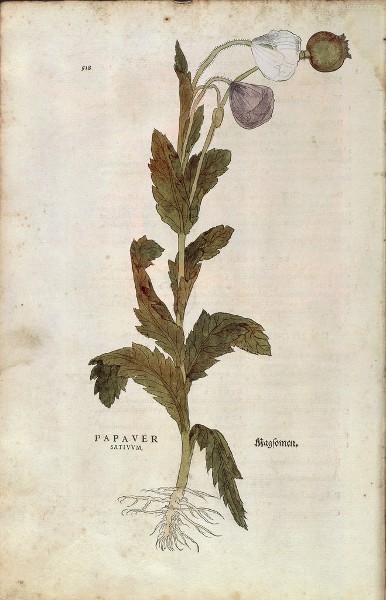
A woodcut from Leonhart Fuchs De historia stirpium commentarii insignes . . . of 1542 depicting Papaver satiuum.
Call it bread seed poppy, lettuce leaf poppy, or opium poppy. Papaver sativum is a beautiful annual whose seeds embellish bagels, fill hamantaschen and mohnkuchen, as an ingredient in salad dressing, and may also be used for an inexpensive, 100% accurate medical test to detect colovesical fistula. That's the seeds. Sap collected from scarifying the immature seed pods yields crude opium. Refined to morphine, its positive uses in medicine have a dark side when altered to heroin and the associated illegal drug trade.

This is not the opium poppy. I think it might be Papaver rhoeas, or corn poppy.
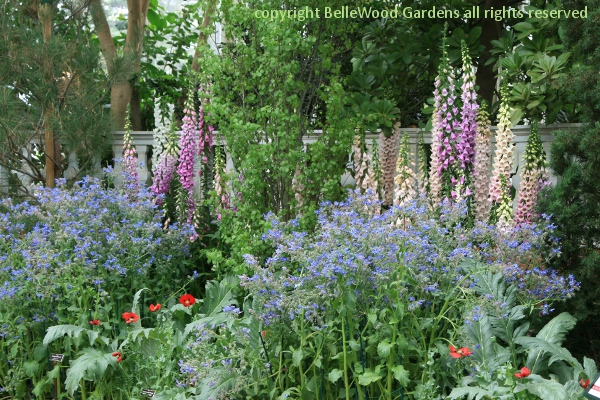
A gently curving brick wall with sculpted balusters and sturdy capping handrail makes a fine
backdrop to the masses of stately tall spires of foxgloves and billowing blue-flowered borage.
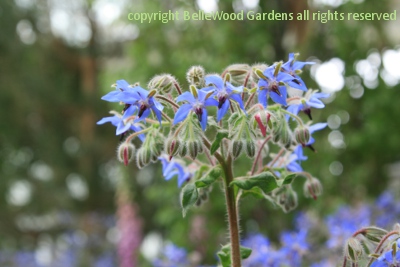
Borage, with its beautiful, true blue, starlike flowers. Bees love to visit the flowers, which are a charming
(and edible) embellishment for a salad, on a cake, or in a summertime Pimm's cup or gin cocktail. The leaves
are one of the seven fresh herbs used to make green sauce, a German accompaniment for boiled potatoes.
In Italy borage is made into a ravioli filling. Medicinally, used as a diuretic, or sudorific - increases sweating.
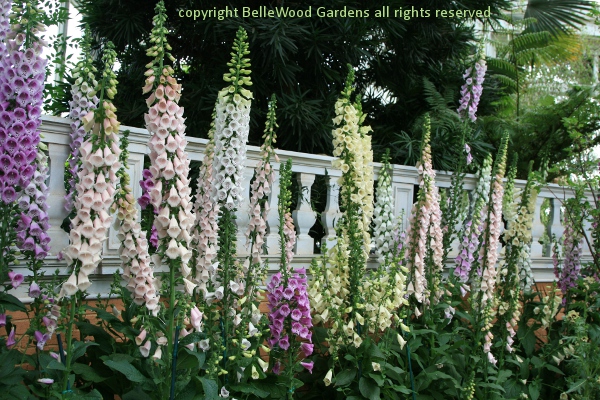
.

Lavender, one of the "hot" herbs. Antiseptic, culinary, aromatic - but not all characteristics will be
found in the same species, let alone one cultivar. Lavandula angustifolia and L. latifolia for the kitchen,
L. dentata for fragrance. And L. stoechas,Spanish lavender, for its antiseptic, piney fragrance.
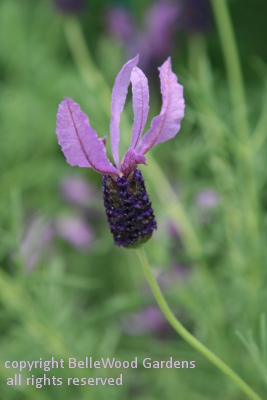
Oversize rabbit-ear petals perk up the two toned flower spike on L. stoechas 'Otto Quast'
named for its originator, nurseryman Otto Quast of Point Reyes Station, California.
Travel back, in time and space, to the Orto Botanico di Padua in Renaissance Italy. Enjoy the beauty of the garden and its plants.
Do be sure to stroll through the other galleries of the Enid Haupt Conservatory and enjoy the Wild Medicine exhibits,
then saunter across the Garden's grounds to the Beaux Arts building and go up to the 6th floor to see the magnificent herbals
on display in the Rondina and LoFaro Gallery of the LuEsther T. Mertz Library. This is indeed a multifaceted event. Enjoy all of it.
The exhibitions are open from May 18 through September 8, 2013. The Garden is easily reached by Metro-North Railroad
and subway, as well as by car. Open year-round Tuesday through Sunday, and Monday federal holidays, from 10:00 a.m. to 6:00 p.m.
For ticket pricing check their web site, or telephone 718.817.8700